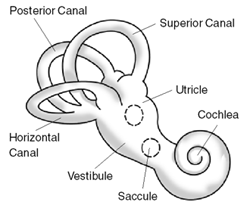Related Research Articles

Migraine is a common neurological disorder characterized by recurrent headaches. Typically, the associated headache affects one side of the head, is pulsating in nature, may be moderate to severe in intensity, and could last from a few hours to three days. Non-headache symptoms may include nausea, vomiting, and sensitivity to light, sound, or smell. The pain is generally made worse by physical activity during an attack, although regular physical exercise may prevent future attacks. Up to one-third of people affected have aura: typically, it is a short period of visual disturbance that signals that the headache will soon occur. Occasionally, aura can occur with little or no headache following, but not everyone has this symptom.

Ménière's disease (MD) is a disease of the inner ear that is characterized by potentially severe and incapacitating episodes of vertigo, tinnitus, hearing loss, and a feeling of fullness in the ear. Typically, only one ear is affected initially, but over time, both ears may become involved. Episodes generally last from 20 minutes to a few hours. The time between episodes varies. The hearing loss and ringing in the ears can become constant over time.

Headache, also knows as cephalalgia, is the symptom of pain in the face, head, or neck. It can occur as a migraine, tension-type headache, or cluster headache. There is an increased risk of depression in those with severe headaches.

Alice in Wonderland syndrome (AIWS), also known as Todd's syndrome or dysmetropsia, is a neuropsychological condition that causes a distortion of perception. People may experience distortions in visual perception of objects, such as appearing smaller (micropsia) or larger (macropsia), or appearing to be closer (pelopsia) or farther (teleopsia) than they actually are. Distortion may also occur for senses other than vision.
Macropsia is a neurological condition affecting human visual perception, in which objects within an affected section of the visual field appear larger than normal, causing the person to feel smaller than they actually are. Macropsia, along with its opposite condition, micropsia, can be categorized under dysmetropsia. Macropsia is related to other conditions dealing with visual perception, such as aniseikonia and Alice in Wonderland Syndrome. Macropsia has a wide range of causes, from prescription and illicit drugs, to migraines and (rarely) complex partial epilepsy, and to different retinal conditions, such as epiretinal membrane. Physiologically, retinal macropsia results from the compression of cones in the eye. It is the compression of receptor distribution that results in greater stimulation and thus a larger perceived image of an object.
Foreign accent syndrome is a medical condition in which patients develop speech patterns that are perceived as a foreign accent that is different from their native accent, without having acquired it in the perceived accent's place of origin.

Reye syndrome is a rapidly worsening brain disease. Symptoms of Reye syndrome may include vomiting, personality changes, confusion, seizures, and loss of consciousness. While liver toxicity typically occurs in the syndrome, jaundice usually does not. Death occurs in 20–40% of those affected with Reye syndrome, and about a third of those who survive are left with a significant degree of brain damage.

Visual snow syndrome (VSS) is an uncommon neurological condition in which the primary symptom is that affected individuals see persistent flickering white, black, transparent, or coloured dots across the whole visual field. Other common symptoms are palinopsia, enhanced entoptic phenomena, photophobia, insomnia, and headaches. The condition is typically always present and has no known cure, as viable treatments are still under research. Migraine and tinnitus are common comorbidities and are both associated with a more severe presentation of the syndrome.

Triptans are a family of tryptamine-based drugs used as abortive medication in the treatment of migraines and cluster headaches. This drug class was first commercially introduced in the 1990s. While effective at treating individual headaches, they do not provide preventive treatment and are not considered a cure. They are not effective for the treatment of tension–type headache, except in persons who also experience migraines. Triptans do not relieve other kinds of pain.
Cyclic vomiting syndrome (CVS) is a chronic functional condition of unknown pathogenesis. CVS is characterized as recurring episodes lasting a single day to multiple weeks. Each episode is divided into four phases: inter-episodic, prodrome, vomiting, and recovery. Inter-episodic phase, is characterized as no discernible symptoms, normal everyday activities can occur, and this phase typically lasts one week to one month. The prodrome phase is known as the pre-emetic phase, characterized by the initial feeling of an approaching episode, still able to keep down oral medication. Emetic or vomiting phase is characterized as intense persistent nausea, and repeated vomiting typically lasting hours to days. Recovery phase is typically the phase where vomiting ceases, nausea diminishes or is absent, and appetite returns. This syndrome is most commonly seen in children usually between ages 3 and 7, however adult diagnosis is quite common. This disorder is thought to be closely related to migraines and family history of migraines.

Prochlorperazine, formerly sold under the brand name Compazine among others, is a medication used to treat nausea, migraines, schizophrenia, psychosis and anxiety. It is a less preferred medication for anxiety. It may be taken by mouth, rectally, injection into a vein, or injection into a muscle.

An aura is a perceptual disturbance experienced by some with epilepsy or migraine. An epileptic aura is a seizure.

Vertigo is a condition in which a person has the sensation of movement or of surrounding objects moving when they are not. Often it feels like a spinning or swaying movement. This may be associated with nausea, vomiting, sweating, or difficulties walking. It is typically worse when the head is moved. Vertigo is the most common type of dizziness.
Acephalgic migraine is a neurological syndrome. It is a relatively uncommon variant of migraine in which the patient may experience some migraine symptoms such as aura, nausea, photophobia, and hemiparesis, but does not experience headache. It is generally classified as an event fulfilling the conditions of migraine with aura with no headache. It is sometimes distinguished from visual-only migraine aura without headache, also called ocular migraine.
Vestibular migraine (VM) is vertigo with migraine, either as a symptom of migraine or as a related neurological disorder.
The classification of all headaches, including migraines, is organized by the International Headache Society, and published in the International Classification of Headache Disorders (ICHD). The current version, the ICHD-3 beta, was published in 2013.
Migralepsy is a rare condition in which a migraine is followed, within an hour period, by an epileptic seizure. Because of the similarities in signs, symptoms, and treatments of both conditions, such as the neurological basis, the psychological issues, and the autonomic distress that is created from them, they individually increase the likelihood of causing the other. However, also because of the sameness, they are often misdiagnosed for each other, as migralepsy rarely occurs.
Short-lasting unilateral neuralgiform headache with conjunctival injection and tearing is a rare headache disorder that belongs to the group of headaches called trigeminal autonomic cephalalgia (TACs). Symptoms include excruciating burning, stabbing, or electrical headaches mainly near the eye and typically these sensations are only on one side of the body. The headache attacks are typically accompanied by cranial autonomic signs that are unique to SUNCT. Each attack can last from five seconds to six minutes and may occur up to 200 times daily.
Abdominal migraine is a variant type of migraine. It primarily affects children, and is rare in adults. It mainly causes episodes of abdominal pain without an accompanying headache. It is poorly understood. It is difficult to confirm the diagnosis, as periumbilical abdominal pain has an extensive differential diagnosis. It may be treated with analgesia in some patients, and other medications. Avoiding triggers can prevent an episode of abdominal migraine.
Flammer syndrome is a described clinical entity comprising a complex of clinical features caused mainly by dysregulation of the blood supply. It was previously known as vascular dysregulation. It can manifest in many symptoms, such as cold hands and feet, and is often associated with low blood pressure. In certain cases it is associated with or predisposes to the development of diseases such as a normal tension glaucoma. Flammer syndrome is named after the Swiss ophthalmologist Josef Flammer.
References
- ↑ Kelman, L. (2006). "The postdrome of the acute migraine attack". Cephalalgia. 26 (2): 214–220. doi:10.1111/j.1468-2982.2005.01026.x. PMID 16426278. S2CID 21519111.
- ↑ Scicurious (18 May 2011). "The postdrome: migraine's silent sister". The Guardian. Retrieved 2012-07-29.
- ↑ "Reye's Syndrome". National Institute of Neurological Disorders and Stroke. Retrieved 2023-02-22.